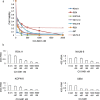rRNA synthesis inhibitor, CX-5461, activates ATM/ATR pathway in acute lymphoblastic leukemia, arrests cells in G2 phase and induces apoptosis
- PMID: 26061708
- PMCID: PMC4627237
- DOI: 10.18632/oncotarget.4093
rRNA synthesis inhibitor, CX-5461, activates ATM/ATR pathway in acute lymphoblastic leukemia, arrests cells in G2 phase and induces apoptosis
Abstract
Ribosome biogenesis is a fundamental cellular process and is elevated in cancer cells. As one of the most energy consuming cellular processes, it is highly regulated by signaling pathways in response to changing cellular conditions. Many of the regulators of this process are aberrantly activated in various cancers. Recently two novel rRNA synthesis inhibitors, CX-5461 and BMH-21, have been shown to selectively kill cancer cells while sparing normal cells. Here, we tested the effectiveness of pre-rRNA synthesis inhibitor CX-5461 on acute lymphoblastic leukemia cells with different cytogenetic abnormalities. Acute lymphoblastic leukemia cells are more sensitive to rRNA synthesis inhibition compared to normal bone marrow cells. CX-5461 treated cells undergo caspase-dependent apoptosis independent of their p53 status. More-over, CX5461, activates checkpoint kinases and arrests cells in G2 phase of cell cycle. Finally, overcoming this G2 arrest by inhibiting ATR kinase leads to robust cell killing. These results show that CX-5461 can be even more potent in combination with ATR inhibitors.
Keywords: ATM/ATR pathway; CX-5461; G2/M arrest; acute lymphoblastic leukemia; rRNA synthesis.
Conflict of interest statement
Authors declare no conflict of interest.
Figures






References
-
- Olson MOJ. The Nucleolus. New York: Springer; 2011.
-
- Olson MO, Dundr M. The moving parts of the nucleolus. Histochem Cell Biol. 2005;123:203–216. - PubMed
Publication types
MeSH terms
Substances
LinkOut - more resources
Full Text Sources
Other Literature Sources
Research Materials
Miscellaneous

